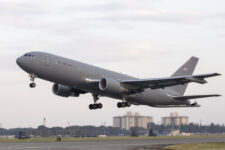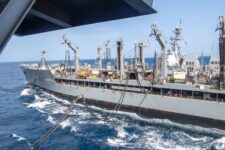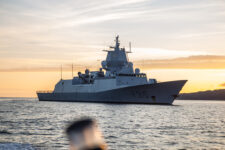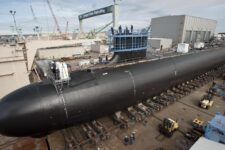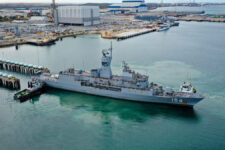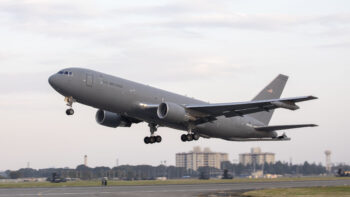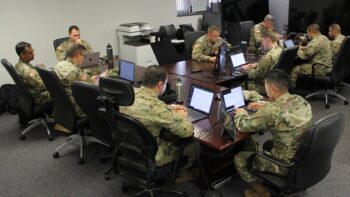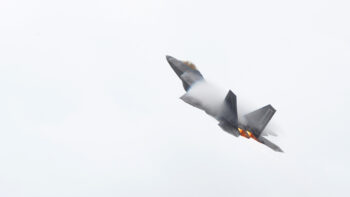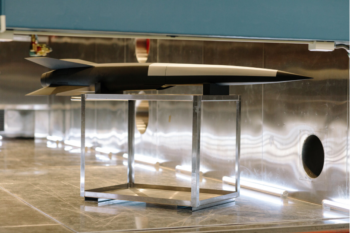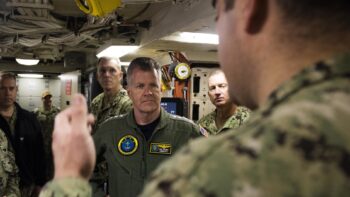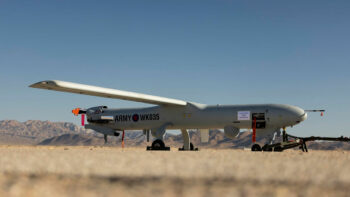
USS John F. Kennedy (CVN 79) moves to a new pier in Dec. 2019.
WASHINGTON: When House and Senate members finally come together after the election to hash out the delayed 2021 budget, they’ll face a new challenge from the Navy: find hundreds of millions of dollars to wrap up work on its newest aircraft carrier.
On Monday evening, the Navy awarded Newport News Shipbuilding a contract valued at up to $315 million for modifications to the USS John F. Kennedy so it can operate F-35C fighters. Normally, such deals would be a routine contract modification, buried amid the billions the Pentagon contracts for on any given day.
But as with everything else surrounding these two programs, nothing is routine. The contract went out despite the fact that the Navy hasn’t figured out a way to pay for it. That’s the job of Congress, which mandated the work take place back in 2020 budget, but didn’t provide any money to make it happen.
Asked about where the funding will come from, Navy spokesman Capt. Danny Hernandez said the issue “is currently under review,” but the service expects the work to have “no impact to the JFK’s baseline delivery date in 2024” — as long as it is found soon.
The $11 billion Kennedy, like the $13 billion USS Gerald R. Ford, was not designed to fly the plane, and requires costly modifications to be able to operate the fifth-generation fighter.
The Navy’s decision to award the contract throws the issue back to Capitol Hill, where lawmakers are about to enter into conference negotiations over the 2021 defense bill, and as the Navy finalizes its 2022 budget submission.
Navy officials said earlier this year that the work on the Kennedy would cause them to hold off on some early work on the third and fourth Ford-class carriers, the USS Enterprise and USS Doris Miller, to ensure the Kennedy retrofits are done correctly before incorporating them on the other ships which have just started their build cycles.
The issue with building the Ford carriers with F-35 capability has hung over both programs as they have struggled to work through a litany of issues that have caused each to be years behind schedule and billions over budget.
Navy officials and analysts have said the service couldn’t wait for the F-35 to be ready before work started on the carriers, so they moved ahead with the idea that modifications could be made once the aircraft was fleshed out and operational.
While both Nimitz and Ford-class aircraft carriers can operate with F-35Cs aboard, significant modifications are required for both classes to fly and sustain the aircraft for extended periods. The ships require the capability to push and fuse all the data the F-35s can generate, along with building additional classified spaces, new jet blast deflectors and other refits. Room also needs to be made for Osprey tiltrotor aircraft, which will replace the Navy’s C-2A Greyhound fleet that cannot haul the F-35’s heavy engines out to the ship.
In the end, the 36-year old USS Carl Vinson, which started its build under the Nixon administration and launched in 1983, will be the first home for F-35Cs at sea. The ship wrapped a $34 million refit in Bremerton Wash. earlier this year, and is conducting sea trials before an expected 2021 deployment.
The plan has been for the USS Enterprise and USS Doris Miller to be built for the F-35 from the start. The Enterprise is slated to deploy in 2028 and Doris Miller will be ready to sail in 2032. In January, the Navy awarded Huntington Ingalls a $24 billion contract for the two ships.
Overall, the Navy’s plans to incorporate F-35s into operations took a hit this summer when the USS Bonhomme Richard caught fire while pierside in San Diego, possibly scuttling the deployment of a ship that was next in line to launch F-35Bs from its flight deck.
The Richard would have been the fifth amphibious ship modified to operate the F-35B, after the San Diego-based USS Essex and Makin Island have been updated, along with the USS America (currently in port in Japan) and the Norfolk-based USS Wasp. (Of course, the Wasp is familiar with the F-35B having conducted a number of its operational tests.)
Last month, Navy Secretary Kenneth Braithwaite told me he’s interested in exploring the idea of building more of these smaller carriers in upcoming budgets.
Asked about Defense Secretary Mark Esper’s suggestion that the fleet of nuclear-powered aircraft carriers could fall from 11 to as low as eight in coming decades, Braithwaite suggested there might be less change afoot than some might think.
“We’re looking at a range,” he said. “I fully believe that number will be pretty close to where it is today.”
The secretary said if the Navy can mimic in some fashion what it did with small carriers in WWII and build more of them “at one-third, one-half the cost” of a carrier while keeping the big-deck nuclear-powered carriers in the fleet, it may be possible to shed a few supercarriers while keeping the Navy’s airpower dominance intact.
Boeing inks contracts worth more than $4B for KC-46s, P-8s
The deals include seven new P-8s and 15 KC-46s.
